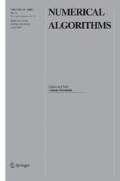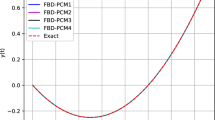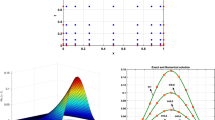Abstract
Classical Runge-Kutta-Nyström (RKN) methods for second-order ordinary differential equations are extended to two-derivative Runge-Kutta-Nyström (TDRKN) methods involving the third derivative of the solution. A new version of Nyström tree theory and the corresponding B-series theory are developed, based on which the order conditions for TDRKN methods are derived. A two-stage explicit TDRKN method of order four and a three-stage explicit TDRKN method of order five are constructed. The linear stability of the new methods is analyzed. The results of numerical experiments show that the new TDRKN methods are more efficient than the traditional RKN methods of the same algebraic order.
Similar content being viewed by others
References
Avdyushev, V.A.: Special perturbation theory methods in celestial mechanics, I. Principles for the construction and substantiation of the application. Russian Phys. J. 49, 1344–1253 (2006)
Bebernes, J., Eberly, D.: Mathematical Problems from Combustion Theory. Springer, New York (1989)
Butcher, J.: Numerical Methods for Ordinary Differential Equations, 2nd edn. Wiley, New York (2008)
Butcher, J., Podhaisky, H.: On error estimation in general linear methods for stiff ODEs. Appl. Numer. Math. 56, 345–357 (2006)
Cash, J.R.: Second derivative extended backward differentiation formulas for the numerical integration of stiff systems. SIAM J. Numer. Anal. 18, 21–36 (1981)
Chan, R.P.K., Tsai, A.Y.J.: On explicit two-derivative Runge-Kutta methods. Numer. Algor. 53, 171–194 (2010)
Enright, W.H.: Second derivative multistep methods for stiff ordinary differential equations. SIAM J. Numer. Anal. 11, 321–3311 (1974)
Fang, Y., You, X.: New optimized two-derivative Runge-Kutta type methods for solving the radial Schrödinger equation. J. Math. Chem. 52, 240–254 (2014)
Fang, Y., You, X., Ming, Q.: Exponentially fitted two-derivative Runge-Kutta methods for the Schrödinger equation. Int. J. Mod. Phys. C 24, 1–9 (2013). Article ID 1350073
Fang, X., You, X., Ming, Q.: Trigonometrically fitted two-derivative Runge-Kutta methods for solving oscillatory differential equations. Numer. Algor. 65, 651–667 (2014)
Franco, J.M.: Exponentially fitted symplectic integrators of RKN type for solving oscillatory problems. Comput. Phys. Comm. 177, 479–492 (2007)
Franco, J.M.: New methods for oscillatory systems based on ARKN methods. Appl. Numer. Math. 56, 1040–1053 (2006)
Franco, J.M.: Runge-Kutta-Nyström methods adapted to the numerical integration of perturbed oscillators. Comput. Phys. Comm. 147, 770–787 (2002)
Hairer, E., Lubich, C., Wanner, G.: Geometric Numerical Integration: Structure-Preserving Algorithms for Ordinary Differential Equations, 2nd edn. Springer, Berlin (2006)
Hairer, E., Nørsett, S.P., Wanner, G.: Solving Ordinary Differential Equations I: Nonstiff Problems. Springer, Berlin (1993)
Hojjati, G., Rahimi Ardabili, M.Y., Hosseini, S.M.: New second derivative multistep methods for stiff systems. Appl. Math. Model. 30, 466–476 (2006)
Holland, P.R.: The Quantum Theory of Motion. Cambridge University Press, Cambridge (2000)
Ismail, G.A.F., Ibrahim, I.H.: New efficient second derivative multistep methods for stiff systems. Appl. Math. Model. 23, 279–288 (1999)
Jordan, D.W., Smith, P.: Nonlinear Ordinary Differential Equations, An Introduction for Scientists and Engineers, 4th edn. Oxford University Press, Oxford (2007)
Joseph, D., Sparrow, E.: Nonlinear diffusion induced by nonlinear sources. Q. Appl. Math. 28, 327–342 (1970)
Kaplan, D., Glass, L.: Understanding Nonlinear Dynamics. Springer, New York (1995)
Kastlunger, K.H., Wanner, G.: On Turan type implicit Runge-Kutta methods. Computing 9, 317–325 (1972)
Kastlunger, K.H., Wanner, G.: Runge-Kutta processes with multiple nodes. Computing 9, 9–24 (1972)
Kristensson, G.: Second Order Differential Equations: Special Functions and Their Classification. Springer, New York (2010)
Landau, L.D., Lifshitz, E.M.: Mechanics, 3rd edn. Butterworth-Heinemann (1982)
Shintani, H.: On one-step methods utilizing the second derivative. Hiroshima. Math. J. 1, 349–372 (1971)
Shintani, H.: On explicit one-step methods utilizing the second derivative. Hiroshima Math. J. 2, 353–368 (1972)
Simos, T.E., Vigo-Aguiar, J.: Exponentially fitted symplectic integrator. Phys. Rev. E 67, 1–7 (2003)
Tsai, A.Y.J., Chan, R.P.K., Wang, S.: Two-derivative Runge-Kutta methods for PDEs using a novel discretization approach. Numer. Algor. 65, 687–703 (2014)
Urabe, M.: An implicit one-step method of high order accuracy for the numerical integration of ordinary differential equations. Numer. Math. 15, 151–164 (1970)
Weinberger, H.F.: A First Course in Partial Differential Equations with Complex Variables and Transform Methods. Dover Publications Inc., New York (1965)
Wu, X., You, X., Wang, B.: Structure-Preserving Algorithms for Oscillatory Differential Equations. Springer, Berlin (2013)
Yang, H., Wu, X., You, X., Fang, Y.: Extended RKN-type methods for numerical integration of perturbed oscillators. Comput. Phys. Comm. 180, 1777–1794 (2009)
You, X., Fang, Y., Zhao, J.: Special extended Nyström tree theory for ERKN methods. J. Comput. Appl. Math. 263, 478–499 (2014)
You, X., Zhao, J., Yang, H., Fang, Y., Wu, X.: Order conditions for RKN methods solving general second-order oscillatory systems. Numer. Algor. 66, 147–176 (2014)
Zhang, Y., Che, H., Fang, Y., You, X.: A new trigonometrically fitted two-derivative Runge-Kutta method for the numerical solution of the Schrödinger equation and related problems. J. Appl. Math. 2013, 1–9 (2013). Article ID 937858
Author information
Authors and Affiliations
Corresponding author
Rights and permissions
About this article
Cite this article
Chen, Z., Qiu, Z., Li, J. et al. Two-derivative Runge-Kutta-Nyström methods for second-order ordinary differential equations. Numer Algor 70, 897–927 (2015). https://doi.org/10.1007/s11075-015-9979-4
Received:
Accepted:
Published:
Issue Date:
DOI: https://doi.org/10.1007/s11075-015-9979-4
Keywords
- Second-order ordinary differential equations
- Two-derivative Runge-Kutta-Nystöm methods
- Nyström tree theory
- Order conditions




